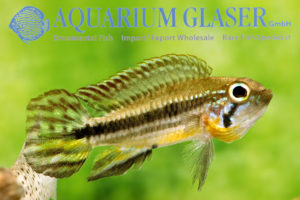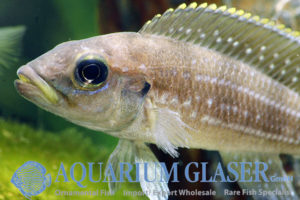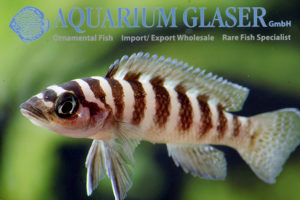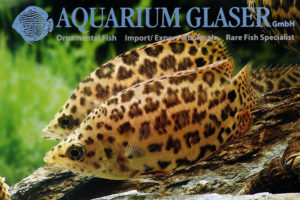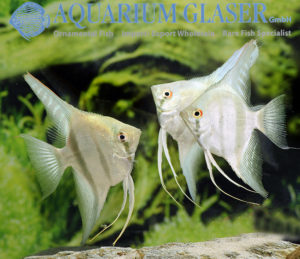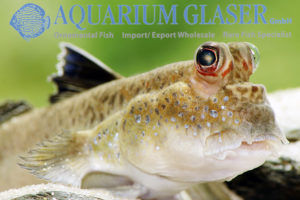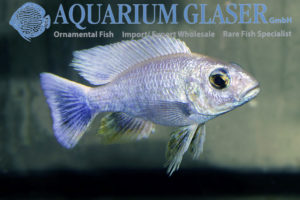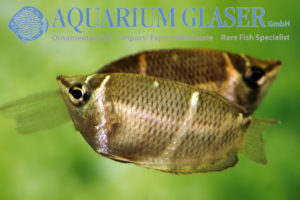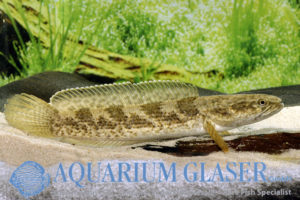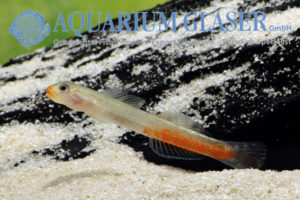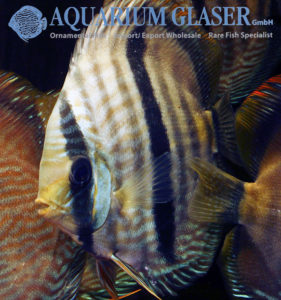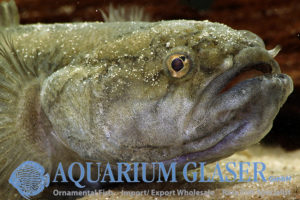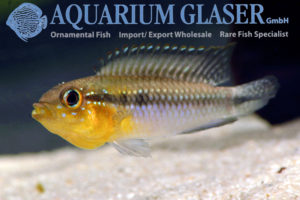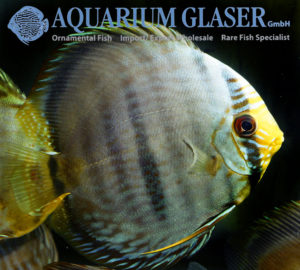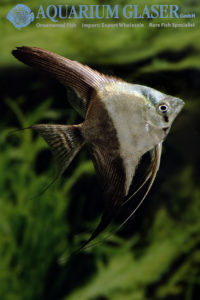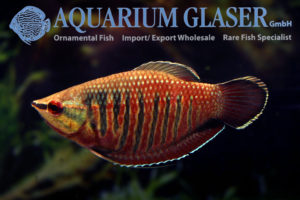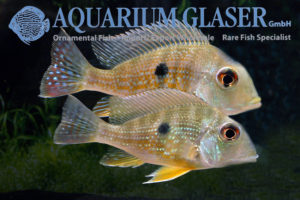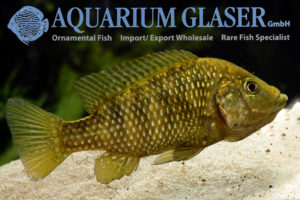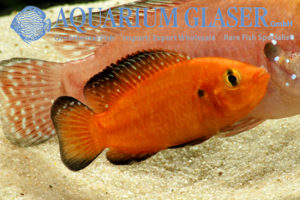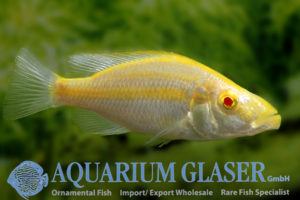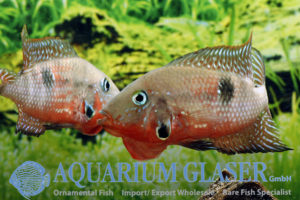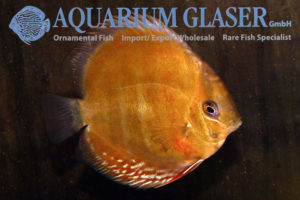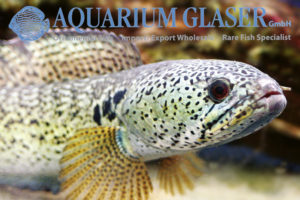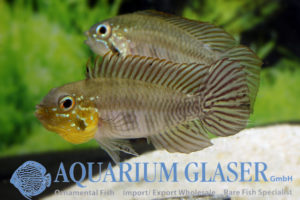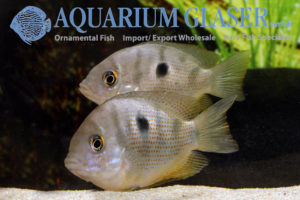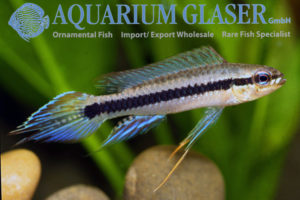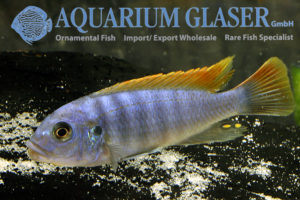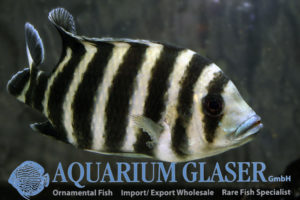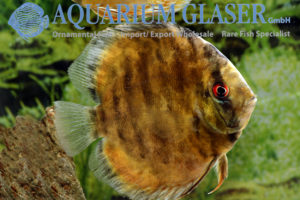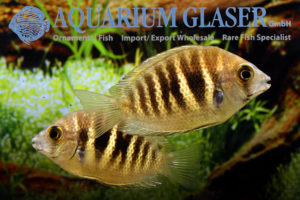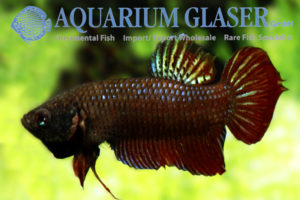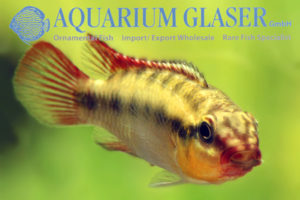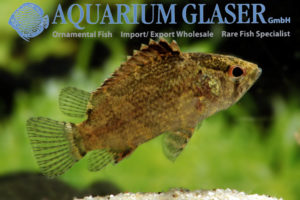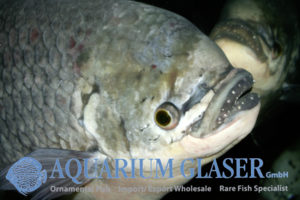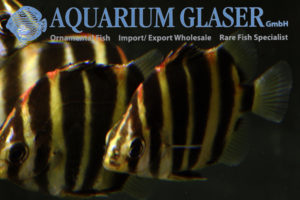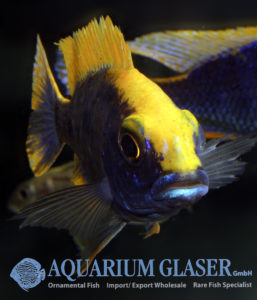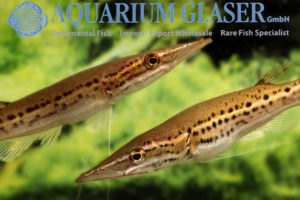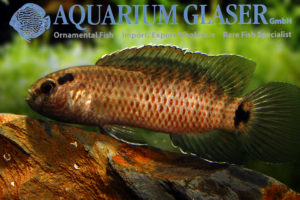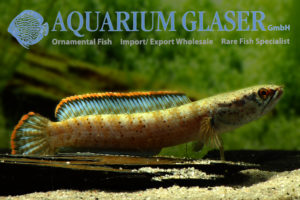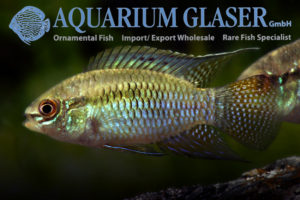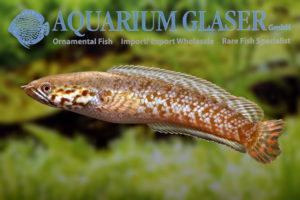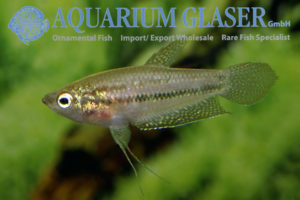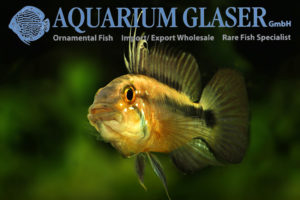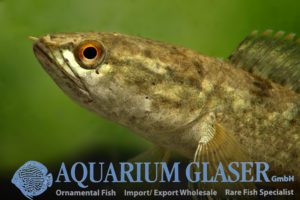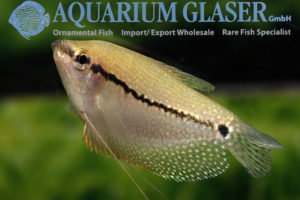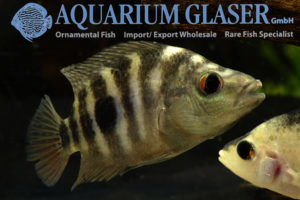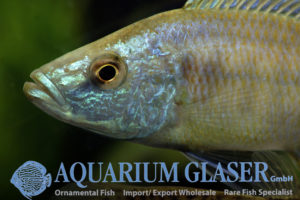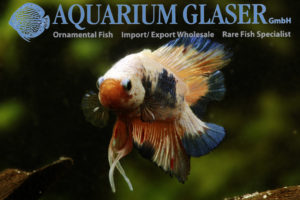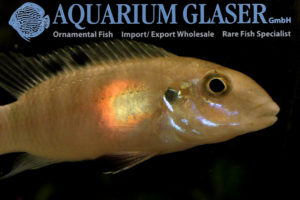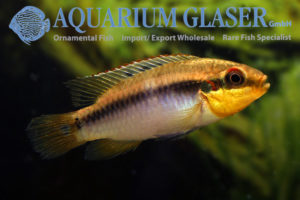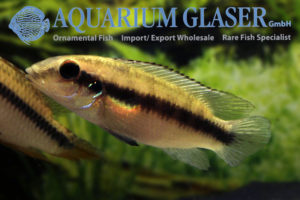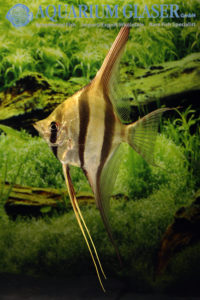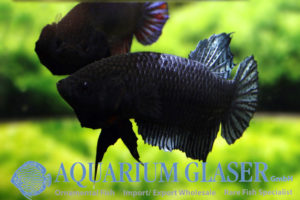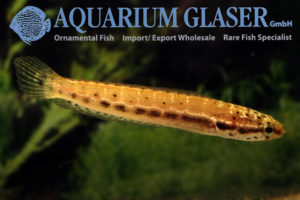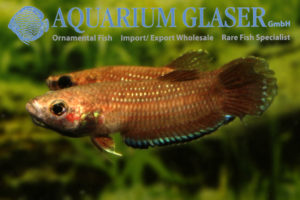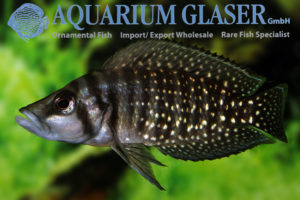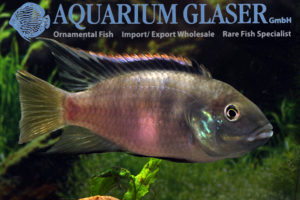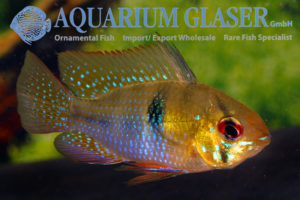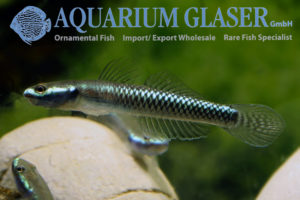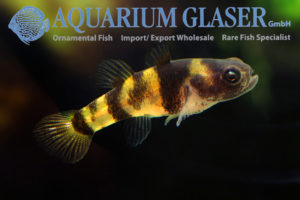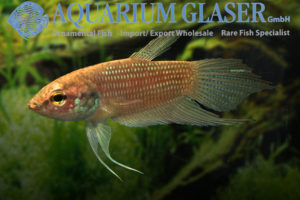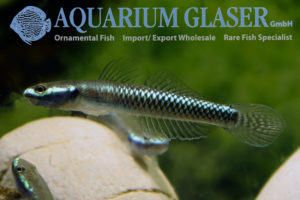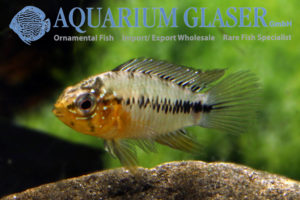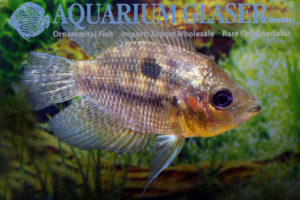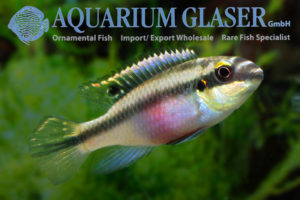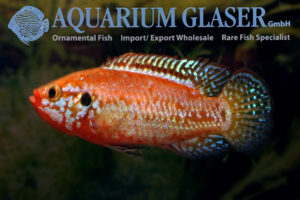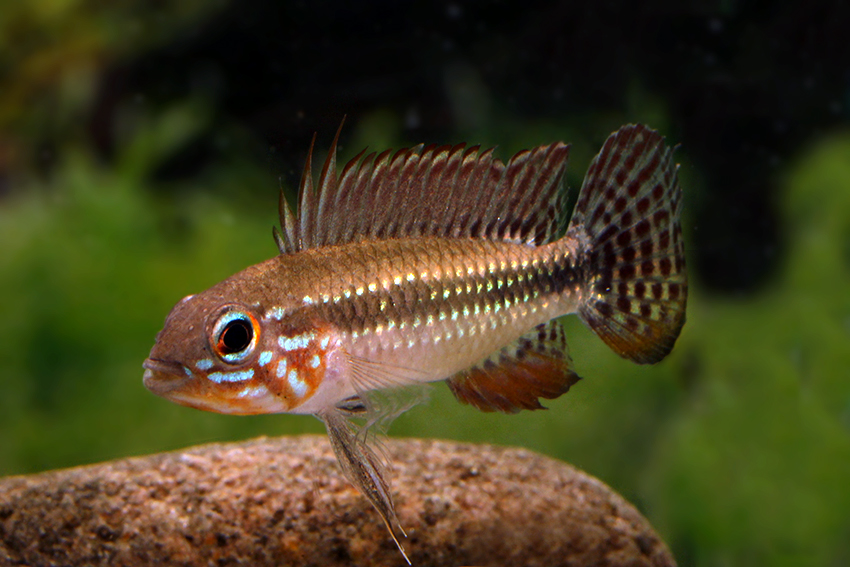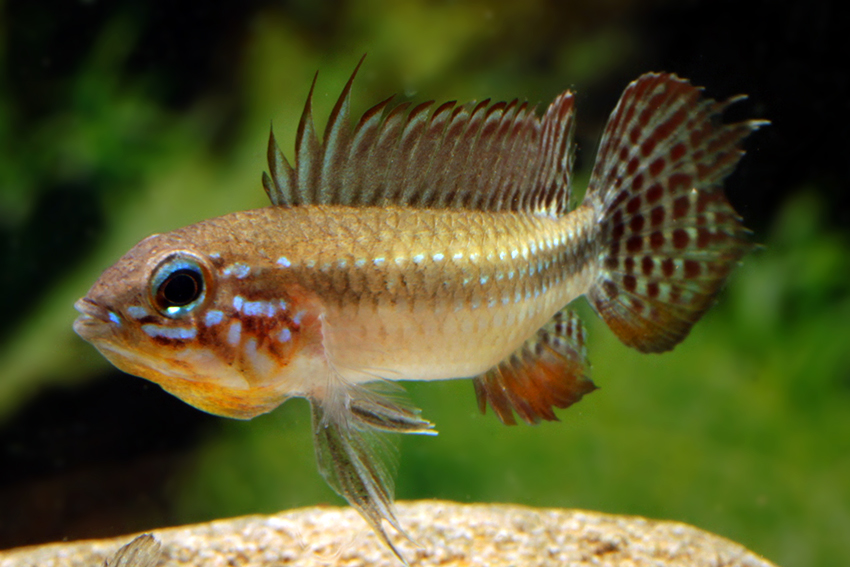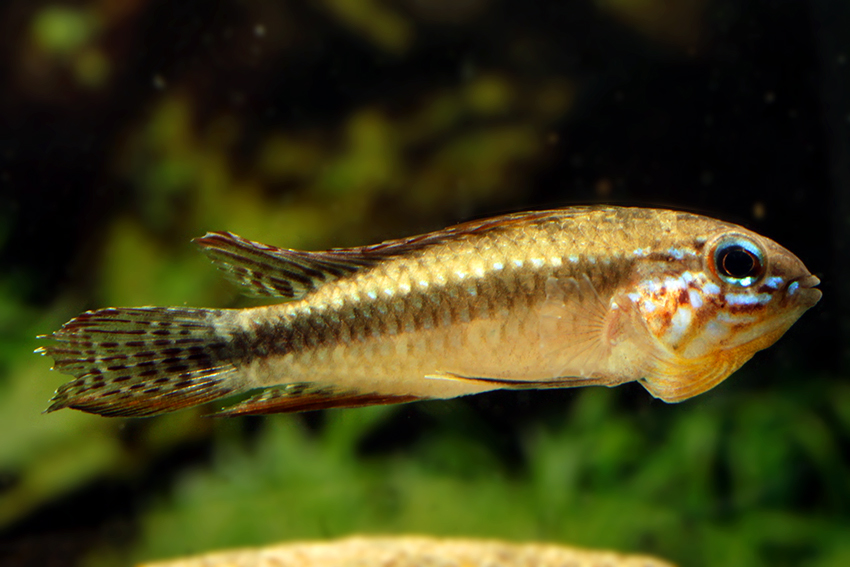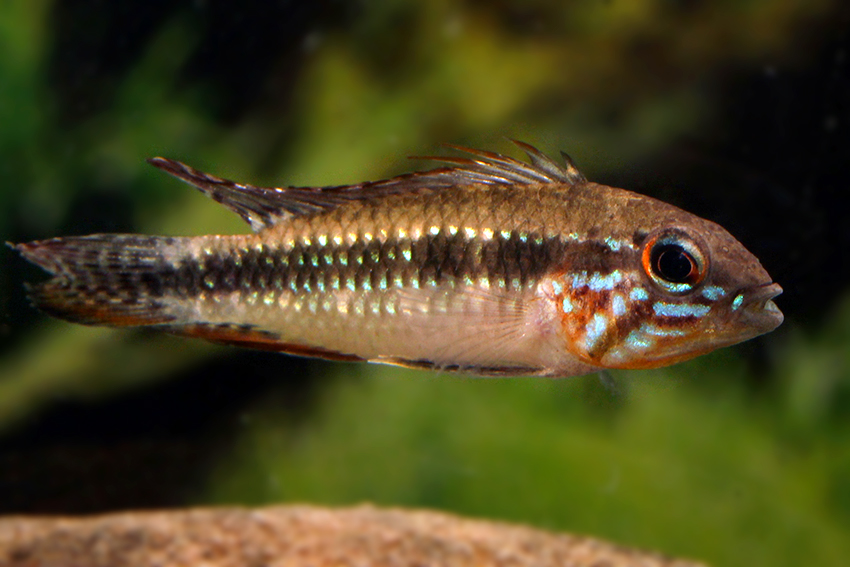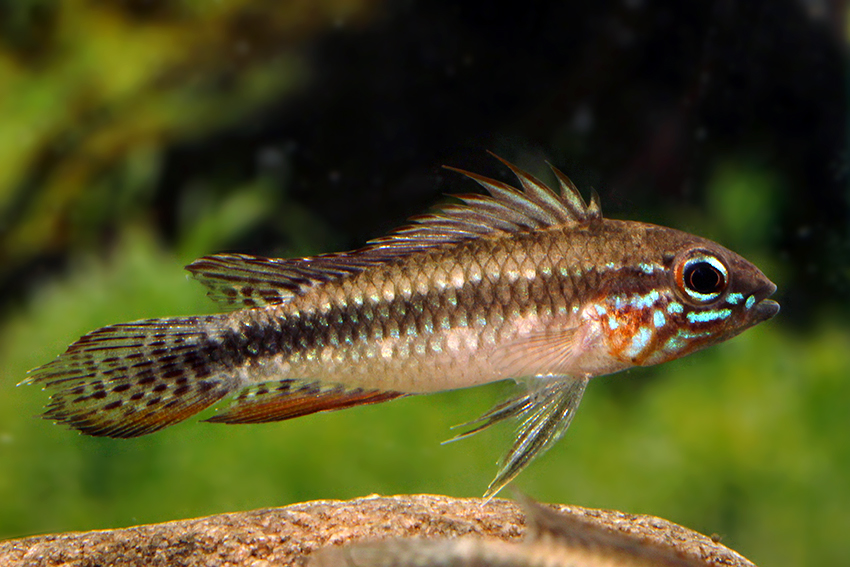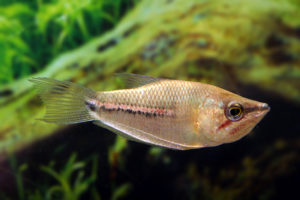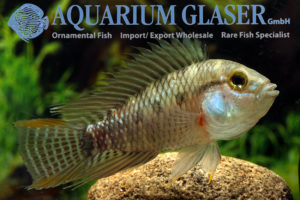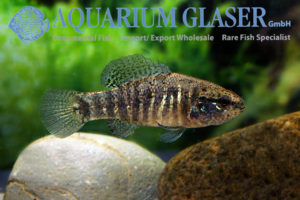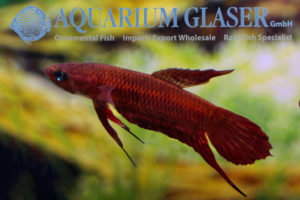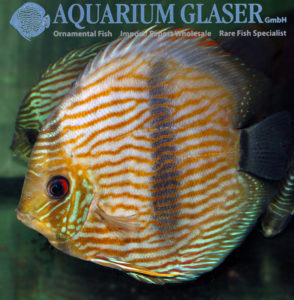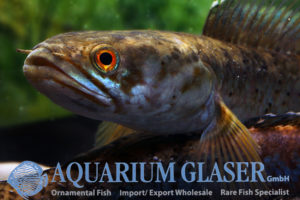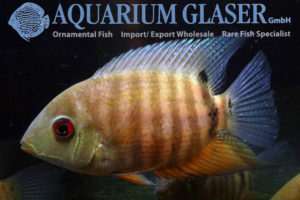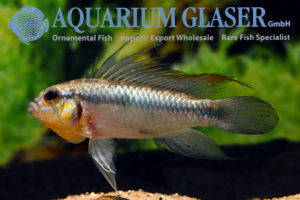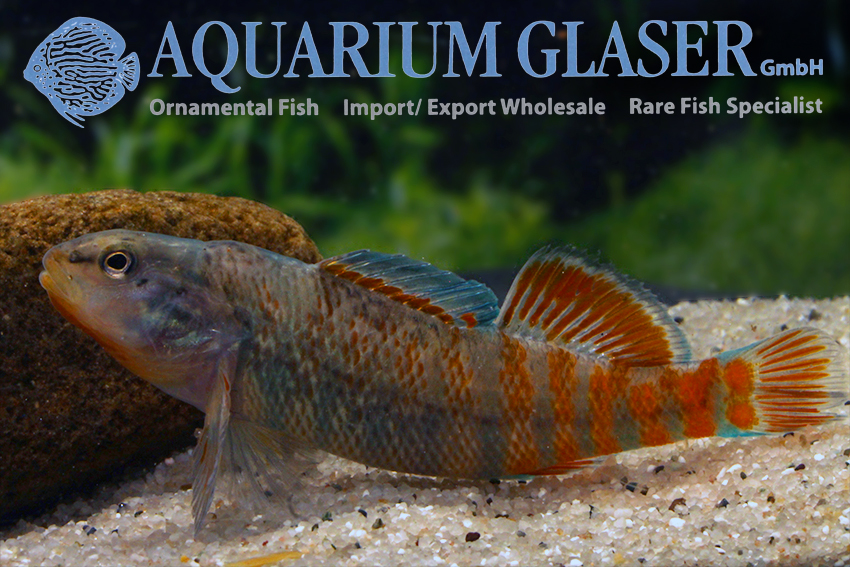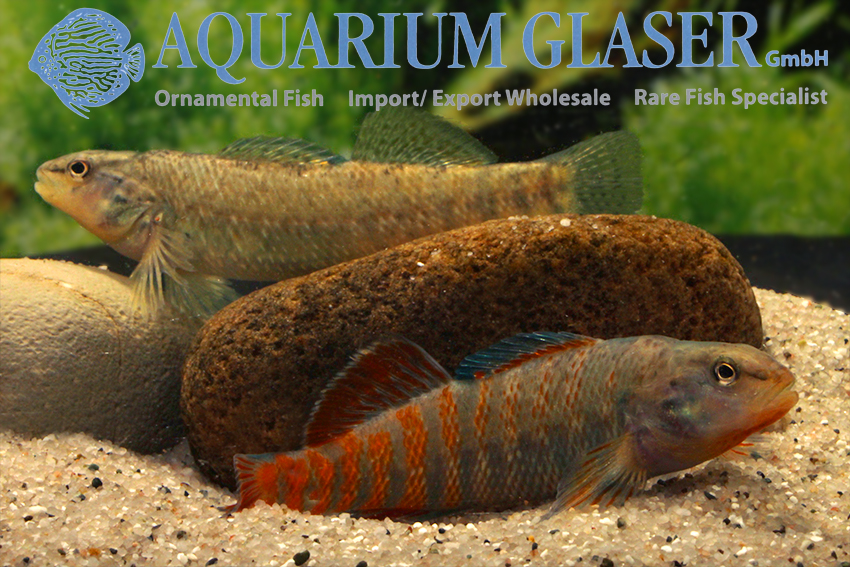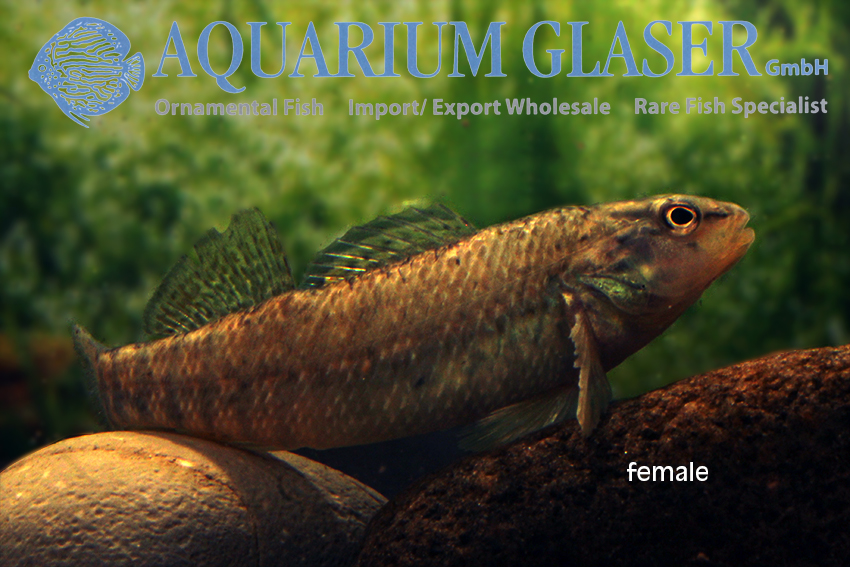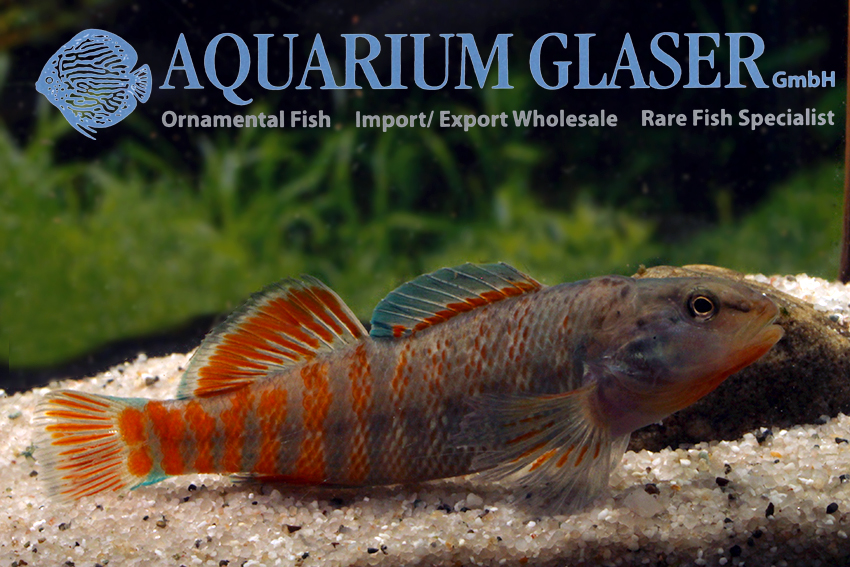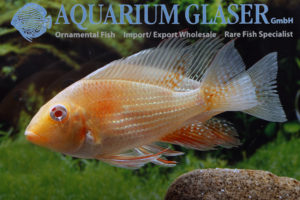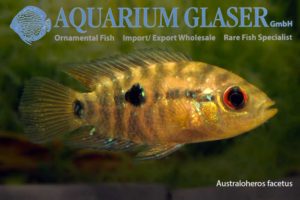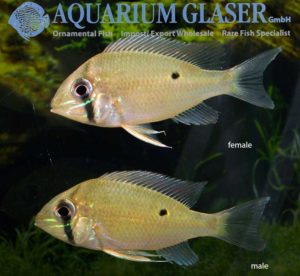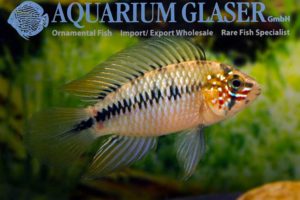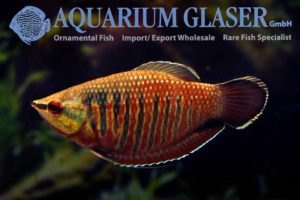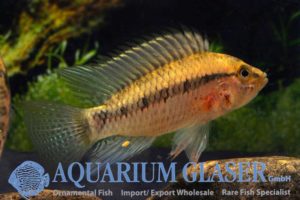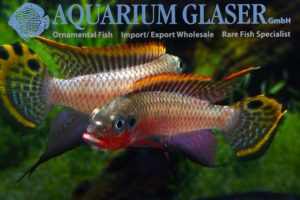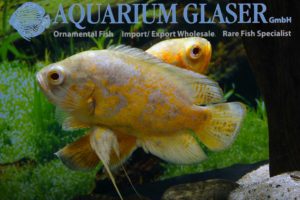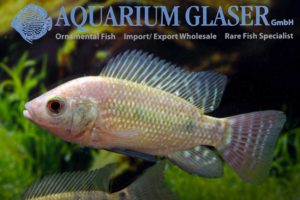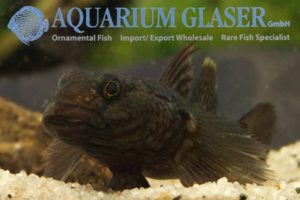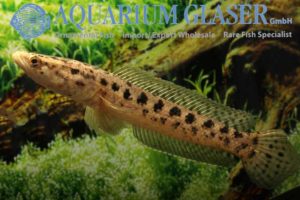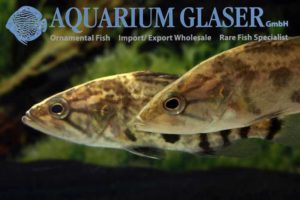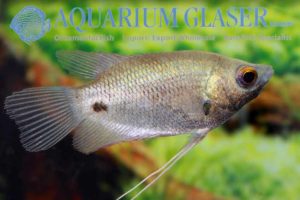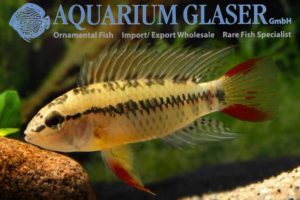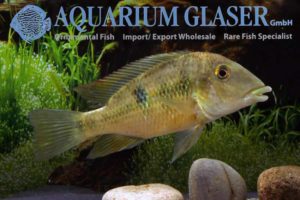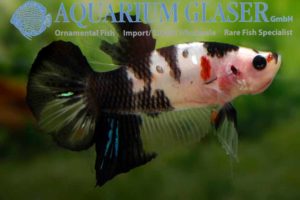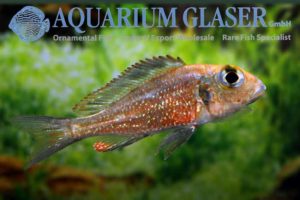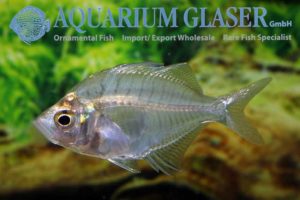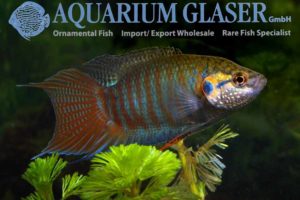Apistogramma mendezi belongs without any doubt to the most attractive members of the genus, but the animals we currently obtained from around Santa Isabel are even more attractive than usual. Of course the males of that population are as polychromatic as all Apistogramma males are, which means that hardly two males are looking identical, but […]
25. Perchlike fishes (917)
-
-
Neolamprologus tetracanthus
This species of cichlid from Lake Tanganyika lives in two different worlds. The fish attains a maximum length of about 20 cm; however, in the wild hardly ever specimens larger than 10-12 cm can be found. On the one hand this fish is a typical inhabitant of sandy areas. Here it feeds on small invertebrates. […]
-
Neolamprologus cylindricus
Among the small species of cichlid from Lake Tanganyika Neolamprologus cylindricus is one of the prettiest. The very obvious ringed pattern makes it unmistakable. In respect of behaviour N. cylindricus is best comparable with the species of the genus Julidochromis. Like these N. cylindricus form fixed pairs (in large aquaria a male may pair with […]
-
Ctenopoma acutirostre
Among the most beautiful anabantoids or labyrinth fish from Africa is Ctenopoma acutirostre, the Leopard bushfish. It can become 15-20 cm long. Its natural habitat is the Congo. It is collected there for the ornamental fish trade in the Stanley Pool region. Here the fish live under the swimming meadows of the water hyacinth (Eichhornia […]
-
Pterophyllum scalare „Belem Sky Blue“
In the year 2015 along with an import of stingrays from Belem, Para, Brazil an angelfish was imported that was unknown to us until then. Already in 2016, in the F1 generation, a few blue mutants with a red iris could be selected. These blue angels from wild parents formed the basis of the selective […]
-
Periophthalmus barbarus
The mudskippers (Periophthalmus) are among the most fascinating fishes at all. One can observe mother nature´s laboratory and how an aquatic animal becomes a landdwelling animal based on the observation of these fishes. The Atlantic Mudskipper (P. barbarus) attains a maximum length of about 15 cm and is one of the larger species of the […]
-
Sciaenochromis fryeri „Iceberg“
Many species of rock-dwelling cichlids from Lake Malawi – the so-called Mbuna – live on isolated places. These place are often many miles away from other suitable habitats. This geografic isolation leads comparatively fast to local colour morphs. Other species of cichlid from Lake Malawi are not that much specialized and can live in a […]
-
Sphaerichthys osphromenoides
Sphaerichthys osphromenoides is the most famous representative of the in southeast Asia indigenous chocolate gouramis. Like other chocolate gouramis Sphaerichthys osphromenoides is a delicate and at least while settling down a sensitive fish. It’s natural biotope are shore areas of small, still and slow-moving black water on the Malayan peninsula and Sumatra. As a typical […]
-
Channa sp. 5-stripe
UPDATE: This species was described in 2018 as Channa quinquefasciata Praveenraj, Uma, Knight, Moulitharan, Balasubramanian, Bineesh & Bleher. A younger invalid synonym is Channa torsaensis Dey, Nur, Chowdhury, Sarkar, Kosygin & Barat, 2019. This comparatively small species of snakehead originates from the north of India (Assam, North-Bengal). The species is not described scientifically yet. Initially […]
-
Apistogramma trifasciata
In case this dwarf cichlid would not exist it would be necessary to invent it for the aquarium hobby. Apistogramma trifasciata is an ideal aquarium inhabitant. The species stays small – males around 5 cm, females around 4 cm. It is completely undemanding regarding water chemistry – keeping and breeding is possible even in medium […]
-
Sicyopus rubicundus
We received from Indonesia once more a nice shipment containing pretty Sicyopus gobies. These gobies are – despite the external similarity – not feeding on Aufwuchs and microfilm like Stiphodon and Sicyopterus, but are little predators that feed on quite large food items. These include also very small fish and shrimps up to a length […]
-
Symphysodon discus Blue Head Tumbira
Here, as promised, another remarkable Heckel variety we currently have in stock: Blue Head Tumbira. One should not think that every specimen of that variety has a solid blue opercle; Tumbira (the name refers to a Tukano community at the bank of the Rio Negro, below Sao Gabriel de Cachoeira) are still wild collected discus […]
-
Odonteleotris macrodon
We obtained from Thailand five specimens of that odd goby which are about 15 cm long. Our first idea was that they would belong to the species Oxyeleotris urophthalmus. The genus Oxyeleotris is repersented by three species in Thailand, two of them with an ocellus in the upper part of the caudal peduncle. Both are […]
-
Apistogramma gephyra wild
Since its scientific description in 1980 this dwarf cichlid is subject of an ongoing debate among keepers and breeders of Apistogramma. Some think that A. gephyra is a mere variety of A. agassizii, others defend its status quo as a separate species. Most likely both parties are right. There can be no doubt that A. […]
-
Symphysodon discus „Heckel Nova Olinda“
We are now in the last third of the current discus season. A particular charakter of this season is the comparably great number of extremely beautiful Heckel discus. We currently have a number of varieties in stock and want to feature them for you. But of course it is not that easy to take pictures […]
-
Pterophyllum scalare „Bicolor Blue“
We can offer this brandnew sport of the Angelfish (Pterophyllum scalare „Bicolor Blue“) for the very first time now. The animals still differ individually in respect of pattern, but especially the front back of all specimens is already blue. The breeder guaranteed us that the parents are full blue bicolor with a real intensive colour. […]
-
Sphaerichtys vaillanti
Finally we can offer again the most beautiful species of Chocolate Gourami: Sphaerichtys vaillanti. The species originates from the Kapuas basin in the Indonesian part of the island of Borneo. S. vaillanti is not only the most beautiful, but also the hardiest species of all Chocolate Gouramis. However, it is nevertheless by no means an […]
-
Geophagus cf. abalios
Currently we have as well larger wild collected specimens and bred ones in stock. G. cf. abalios is a beautful, ovophilous mouthbrooider and originates from Venezuela. The fish have bred in our showroom. At that time they had a total length of about 8 cm, so we initially thought they would represent a dwarf variety. […]
-
Danakilia sp. Sukoray
Danakilia are very strange cichlids that were described scientifically only very recently and were – of course – totally unknown in the hobby, until Anton Lamboj was able to bring some specimens alive back to Austria from Etritrea. He made this expedition together with Giorgio Chiozzi from the Milan Museum. One of the new discovered […]
-
Hemichromis exsul
Red jewel cichlids are wonderful aquariumfishes despite the fact that sometimes very quarrelsome individuals appear. For scientists the complex of species of red jewel cichlids remains a mess. Many meristic features overlap and additionally many species are highly polychromatic. Hemichromis exsul has been described scientifically already in 1933 under the name of Pelmatochromis exsul. Type […]
-
Dimidiochromis compressiceps Albino
There is no consensus among aquarists regarding albino sports. One part of the hobbyists find them awkward, the other part simply wonderful. Readers belonging to the first group: please accept our excuse, next week a different fish will be subject of the post again. For all the others: The Malawi-Eyebiter (Dimidiochromis compressiceps) has a bad […]
-
Thorichthys meeki
The Firemouth (Thorichthys meeki, formerly Cichlasoma meeki) originates from Mexico and belongs to the most popular cichlids at all. This popularity is not at least due to the impressive face mask of the species. No other species of cichlid shows in such perfectness the bottom of the mouth and the deep red skin that covers […]
-
Madeira-Discus arrived!
There are so many varieties of discus known, but none of the wild collected fish are as variable as the ones from the Rio Madeira. Basically speaking, the Madeira discus is a brown-blue one. The brown morphs of that variety very often exhibit a high degree of red and/or yellow colour on the body, while […]
-
The total ban of Channa in the EU is off the table!
According to our very well informed sources the application to ban the trade and keeping of all species of snakehead (Channa) in the EU has been refused. Obviously just in time the contradiction could be submitted that the ban of a complete genus is not according to the law, but that in any case for […]
-
Apistogramma gibbiceps
Currently we received once more this pretty dwarf cichlid from the Ro Negro basin. It is a typical company of the cardinal tetra in the wild. The species Apistogramma gibbceps cannot be confused with any other species of Apistogramma when it shows the species-specific vertical bars on the belly. Sadly these bars are not visible […]
-
Etroplus maculatus
The Indian cichlid, Etroplus maculatus, is a very popular aquarium fish and never disappeared after its first importation again. Recent research suggests that Etroplus is not a close relative of the cichlid family, but rather of the damselfishes (Pomacentridae). However that does not mean anything for the hobby. Etroplus maculatus can be kept and bred […]
-
Taeniacara candidi
This dwarf cichlid from Brazil is a very pretty species. Currently we have charming wild collected specimens in a good number in stock. Principically speaking Taeniacara – there is only one known species, T. candidi – is a very elongated Apistogramma. So the aquarium biology is quite comparable in both genera. That means the fish […]
-
Maylandia greshakei
The zebra cichlids fro Lake Malawi are very popular aquarium fishes. Among them is Maylandia greshakei, which looks very special due to its bright orange dorsal fin. In the wild – the fish is endemic to Lake Malawi – it is restricted to only two comparatively small areas, eg Crocdile Rocks and Makokola Reef, both […]
-
Tilapia buettikoferi
There are several species of cichlid termed „zebra cichlid“ in the aquarium hobby. However, none of the has a black-and-white pattern like the wild horse, but a green or blue basic colour. Examples are „Zebra cichlid“ from Central America (Amatilania nigrofasciata, formerly placed in Cichlasoma) or the „zebras“ from Lake Malawi (genus Maylandia). A real […]
-
A little sensation: the first documented OB discus!
A few weeks ago we received a shipment of hald grown wild collected discus via Manaus. The animals acclimatised very well. As soon as they showed the normal coloration we found that there was one very special animal among them. It was blotched. Initially we thought that the animal would be sick, but it feeds […]
-
Etroplus canarensis
Only three species of cichlid are found in Asia, all of them belong to the genus Etroplus. But many scientists believe that Etroplus are closer to damsels than to cichlids. Anyway, all three species are marvelous aquarium fish. Two of them, E. maculatus and E. suratensis are wide spread. There was no trace of […]
-
Betta splendens Wild
The wild forms of the Betta splendens-group are very difficult to determinate, even for specialists and in some cases a safe determination will fail at all. Currently these species are placed in the group: Betta imbellis, B. mahachaiensis, B. siamorientalis, B. smaragdina, B. splendens, and B. stiktos. Inside this group one can differentiate two subgroups, […]
-
Congochromis sabinae and C. sp. „Green Speckle“
We obtained these beautiful and extremely rarely offered dwarf cichlids as bycatches with other fishes from the Congo. Congochromis sabinae was prior to its scientific description known under a number of trade names: C. sp. „Bloody Mary“, C. sp. „Gemena“, C. sp. „Bamanja“ or C. sp. „Makoua, all of them also in the combination with […]
-
Nandus nebulosus
We received from Thailand the only rarely offered Nandus nebulosus. There are two, pretty similar species of Nandus occuring in Thailand: thre deep-bodied N. oxyrhynchus from the basins of the large rivers Mekong and Mae Klong and the somewhat more slender, short nosed species N. nebulosus from the south of the country. However, regions are […]
-
Osphronemus exodon
Until the end of the 20th century it was believed that the giant gouramies would be represented only by one single species. But then a number of additional species was recognized, among them Osphronemus exodon from the Mekong river. Juveniles look very much alike common giant gouramies (O. goramy), only educated people note the higher […]
-
Scatophagus tetracanthus
We received this top rarity from the Pacific coast of Eastern Africa. For the first time ever we can offer 27 specimens. Like all scats this species is completely euryhalin, this means it can change freely between the sea and freshwater; this is their typical behaviour in the wild. Much more important than the salt […]
-
Otopharynx lithobates
Today we took the photo equipment in our fishhouse (instead of taking fish from the fishhouse in the phototank), for here in one of our tanks a great show is presented: 50 sexually ripe (7-10 cm long) Otopharynx lithobates, more than half of them males in breeding mood. Wow. In the natural habitat, males of […]
-
Luciocephalus pulcher
The pikehead, Luciocephalus pulcher, is a highly specialized anabantoid, a relative of the chocolate gouramies. Like the latter the pikehead is a mouthbrooder. Luciocephalus is the only true predator among the various anabantoids; in its natural habitat it feeds preferably on shrimps. The calm, beautiful animal (Latin pulcher = beautiful) would for sure be a […]
-
Badis autumnum
The number of species of chameleon fish has increased drastically in the past years. Until the year 2002 only one genus and ones species with four subspecies were accepted, now there are two genera (Badis and Dario) with 23 species in Badis and 6 in Dario. One of the latest described species is Badis autumnum, […]
-
Channa sp. „Burmese Red Rim Rainbow“
Finally we were able to import a number of specimens of this exttemely beautiful, small species of snakehead from Burma. The fish attain a maximum length of about 12-15 cm and are a close relative of Channa gachua. However, the body of „Red Rim“ is much more depressed. In respect of coloration one feature makes […]
-
Laetacara curviceps
Quite a long time before the species of Apistogramma became popular in the hobby, another species of dwarf cichlid from Brazil was a favorite aquarium fish: Laetacara curviceps, the flag acara. At these times it was called Aequidens curviceps. Sadly the fish became rather rare in the past years. So we are glad that we […]
-
Apistogramma sp. Marandu
We received from Peru for the very first time this new, interesting and beautiful species of Apistogramma; sadly no further information on the origin is available. As the new fish cannot be applied for sure to an already described species, we simply adopted the name the exporter gave to the fish. Marandu belongs to the […]
-
Channa bleheri
Currently is the import season for one of the most beautiful species of snakehead, the rainbow snakehead (Channa bleheri) from the state of Assam in India. The species is not only very colorful, but also stay comparatively small (at least in comaprison with some other snakeheads), namely 15-20 cm. Moreover this species is – again […]
-
Trichopsis schalleri
Schaller´s Croaking Gourami is sadly only very occassionally available in the trade. The very pretty fish originates from central Thailand; it attains a length of about 4 cm. So it becomes larger than the Croaking Dwarf Gourami (Trichopsis pumila, 2,5-3 cm), but stays smaller than the common Croaking Gourami (T. vittata, up to 6 cm). […]
-
Apistogramma atahualpa
Before its scientific description this beautiful species of dwarf cichlid was known in the hobby as the „Sunset-Apistogramma“. And in fact the body coloration of a female during brood care reminds one in a sunset. The scientific name, atahualpa, refers to the last great ruler of the Inka empire: Atahualpa. He was captured by the […]
-
Channa harcourtbutleri
We obtained some specimens of this only very rarely offered snakehead from Burma. The species is a very close relative of Channa gachua. In fact, it has been considered to be a mere synonym of C. gachua for a very long time. But Ng, Ng & Britz could show in 1999 that C. harcourtbutleri is […]
-
Trichogaster leerii Wild
For the first time we obtained wild collected pearl gourami from Thailand. This is worth mentioning for several reasons. First, it is very ambigously discussed in the scientific literature wether the species occurs in Thailand at all; twice: the wild populations of the pearl gourami are declining terryfing fast, for the species is strictly adopted […]
-
Amphilophus xiloaensis
In the lakes of Nicaragua a group of cichlids evolved, which is very interesting from a biological point of view: the Midas cichlids. Formerly they were classified only in two or three variable species within the catch-all genus Cichlasoma: Cichlasoma citrinellum, C. labiatum, and C. zaliosum. Nowadays they are placed in the genus Amphilophus. These […]
-
Dimidiochromis strigatus
The genus Dimidiochromis comprises currently four accepted species. Only one of them, D. compressiceps, is found in the trade on a regular basis and has become an ornamental fish so far. D. strigatus can still be considered a rarity in the trade. We have the species stocked now for the first time, our fish are […]
-
Another new sport of fighting fish: Fancy Dragon Pla Kat
Fighting fish are absolutely popular currently. The splendid colours, the easy breeding, the interesting behaviour and the unproblematic keeping are the reasons. Against other fish than conspecifics Betta splendens are usually completely peaceful; the only general exception are fancy guppys, as these are often erronously taken for male fighting fish and attacked. Until now the […]
-
Wallaceochromis signatus
Prior to its scientific description this species as been known in the hobby under the names of Pelvicachromis sp. „Bandi1“ or „Guinea“. The species can be always easily recognized by the black tailspot of the female. Usally the female has only one black spot in the dorsal fin; the fact that the photomodel from our […]
-
Pelvicachromis roloffi
The maybe rarest of all dwarf cichlids of the genus Pelvicachromis is P. roloffi. So we are very glad that in our current import from Guinea some specimens were included. This species depicts in almost all different moods a clearly visible, horizontal band. The females are – as usual in Pelvicachromis – the more colorful […]
-
Wallaceochromis humilis „Kasewe“
Finally we were able again to organize an import of – inter alia – dwarf cichlids from Guinea. Formerly all these fish were placed in the genus Pelvicachromis, but the species humilis, signatus, and rubrolabiatus have been transferred to the newly described genus Wallaceochromis in 2016. The naming of the different local populations of these […]
-
Wonderful bred Altum angels available!
The Altum angel (Pterophyllum altum) is extremely demanding during the rearing period. If the breeder makes even a minor mistake in respect of water quality or the food this results at once in a life-long deformation of the fish. These gnarled ventral fins, crooked anal fins or defects of the operculum are not heritable; so […]
-
Betta splendens – real fighter Pla Kat Luk Maw
It is a well known fact that the Betta splendens kept in the aquarium hobby as ornamental fish do not represent the species as it appears in the wild, but a domesticated fish. Initially this sport has been bred for combats, similar like sports of cocks and dogs. Only in the 1920ies, when supplying ornamental […]
-
Channa bankanensis
Many species of snakehead look very attractive as juveniles. Channa bankanensis is no exception from that rule. The reason for the sometimes extraordinary change in coloration is the behaviour. Juvenile Channa are usually schooling fish. Depending on the species they swim in close schools up to a length of 3 cm or even 15 cm. […]
-
Betta simplex
This small (5-6 cm) mouthbrooding species from Thailand is a very nice addition to the good assortment of wild collected Betta we currently have in stock. Betta simplex is a very close relative to the species Betta picta from Java, Betta falx from Sumatra, and Betta taeniata from Borneo. All the mentioned species share the […]
-
Altolamprologus calvus
This cichlid belongs to the most attractive species of the family from Lake Tanganyika. It attains a maximum length of about 13 cm. Despite the lurky look the fish is one of the most peaceful species of cichlid at all. One can say as a rule: if another fish is too large to serve as […]
-
Benitochromis nigrodorsalis
We can cvurrently offer a very small number of German bred specimens of a top rarity among the cichlids of western Africa: Benitochromis nigrodorsalis. This species has been described scientifically only in 2001. It originates from Cameroon and the island of Fernando Poo. Prior to the scientific descrption the fish was known as „Chromidotilapia finleyi […]
-
Wild Rams
Due to the regularly offered, amazing bred sports of the Ram (Mikrogeophagus ramirezi) one tends to forget, how breathtaking beautiful the wild collected fish is already. Currently we have fully grown, wild collected Rams from Venezuela in stock. By the way: wild collected Rams become only about 5 cm long (in males), females even stay […]
-
Stiphodon semoni
Once more we were able to import one of the gorgeous gobies belonging to the genus Stiphodon. This time we most likely received Stiphodon semoni, a species that is known for a long time already scientifically. It has been described already back in 1895. The species has a wide distribution, it is known from Sulawesi, […]
-
Brachygobius sabanus Thailand
We received this pretty species of bumblebee goby from Thailand. The determination of bumblebee gobies often proofes to be quite tricky; usually a big questionmark has to be set behind the names. Brachybobius sabanus has been described initially from Borneo (Sabah), our fish have been collected in Thailand. But the illustration accompanying the original description […]
-
Betta ferox
Sometimes we receive wild collected specimens of that very rare species of Betta. The mouthbrooding species is known so far only from a very small area in Thailand (Bori Pat). Here the fish inhabit brooks with soft and slightly acidic water. The water temperature there is around 25°C. Maximum length reported is about 8 cm, […]
-
Stiphodon semoni
Once more we were able to import one of the gorgeous gobies belonging to the genus Stiphodon. This time we most likely received Stiphodon semoni, a species that is known for a long time already scientifically. It has been described already back in 1895. The species has a wide distribution, it is known from Sulawesi, […]
-
Apistogramma borellii Paraguay wild
Recently we received beautiful wild collected specimens of A. borellii from Paraguay. This species is an ideal aquarium fish. In contrast to many other species of the genus A. borellii is completely undemanding regarding water chemistry. Even in medium hard, slightly alcalic water the species thrives well and even breeds. The behaviour of A. borelli […]
-
Chaetobranchopsis australis
Here it is: the cichlid with the probably most interesting mode of feeding from Paraguay! Chaetobranchopsis australis is specialized in feeding small planktic organisms. The up to 12-14 cm long fish swallows water like a vacuum cleaner and sieves the plankton with long gill rakers out of it. Obviously at the time of our importation […]
-
Pelvicachromis pulcher wild Yellow
The yellow sport of Pelvicachromis pulcher originates from southwest Nigeria. Here they are collected west of the Niger delta in the area of the Ethiop river. The names Yellow, Red or Green for the different sports of P. pulcher refers to the colour of the opercles; all of them get a red belly at times. […]
-
Hemichromis sp. Neon
If the only thing a hobbyist cares for for be the coloration, we would hardly need other species than Jewel Cichlids. The „Neon“ is an artifical sport, most probably bred by crossing different species and selection. The blue iridescent spots, present in most species of Hemichromis, are much larger in the „Neon“ sport. With respect […]
-
Sphaerichthys acrostoma
The Golden Chocolate Gourami may be the least attractive of all Chocolate Gouramis in respect of coloration, but it is nevertheless a very interesting species. The fish is the rarest of all Chocolate Gouramis as well in the hobby as in the wild. So we are very glad in case we are able to offer […]
-
Apistogramma eunotus „Rio Tapiche“
Apistogramma eunotus is among the species of Apistogramma with the deepest body of all. The species can be told apart from other, similar species, best by the large blueish spot on the opercle. We obtained recently very different specimens of A. eunotus from the Rio Tapiche in Peru. They differ in many respects from typical […]
-
Elassoma zonatum
Even our grandfathers will remember the dwarf sunfishes. The tiny, hardly 3 cm long fish are ideal inhabitants for small tanks that are not heated. Elassoma originate from the USA. Formerly only one species of the genus was represented in the hobby, namely Elassoma evergladei. But in the meantime additional species became avialable. Among them […]
-
Betta coccina
Finally we can offer once more one of the beautiful Bettas belonging to the relationship of the „small red ones“: Betta coccina. The Vinered fighter, also called the Blue spot fighter, comes from Sumatra, Jambi province. Like all these „small red ones“ it occurs in forests. Here the fish live among the dead leaves of […]
-
Discus Heckel Cross Jatapu
The high season for wild collected discus starts around October and ends in April. Nevertheless, good wild collected discus are available the whole year throught! Some varieties are in general very rarely offered, a good example are the so called Heckel Cross from the Rio Jatapu. They are real beauties! The out-of-season summer discus have […]
-
Channa sp. Meghalaya
Currently is the season for species of Channa from India. Every now and then we can offer the gorgeous Channa pardalis, which is also known in the hobby under the name of „True Blue“ (see http://www.aquariumglaser.de/en/fish-archives/channa_sp_true_blue_en/). There is a second, very similar Channa, traded under the name of Channa sp. Meghalaya. There is a rumour […]
-
Heros liberifer German bred
The mouthbrooding species of Heros from Venezuela has finally a widely accepted scientific name: Heros liberifer. Please see http://www.aqua riumglaser.de/en/fish-archives/the_mouthbrooding_heros_from_venezuela_a_new_species_heros_liberifer_en/ for detailed information on that case. From time to time we can offer beautiful, 10-14 cm long German bred specimens of that rare fish. For our customers: the animal has code 682945 on our stocklist. Please […]
-
Apistogramma trifasciata „Rio San Martin“
We received very nice German bred specimens of that dwarf cichlid. The specimens are descendants of the yellow-headed population that has been initially collected by the well known dwarf cichlid specialist and ichthyologist Dr. Wolfgang Steack in the Rio San Martin (Rio Guapore basin). He portrayed that population in detail in the DCG Sonderheft 2008 […]
-
Apistogramma personata Mitu
The identity of this dwarf cichlid – it belongs to the absolute top-rarities – is under discussion. It is a fact hat it has been collected for the first time in 1995 by Uwe Werner and company near Mitu, Colombia. The city of Mitu is placed at the banks of the Rio Vaupes. Uwe was […]
-
Acarichthys heckelii Albino
We received this extraordinary and beautiful sport of Acarichthys heckelii from Taiwan. A. heckelii is a comparatively large species of cichlid that can attain over the years a total length of more than 20 cm. And the fish becomes more and more beautiful with every year! The species is very peaceful. Aquarium maintenance is comparable […]
-
Chanchitos
The very first species of cichlid that was ever kept in private aquaria was the Chanchito. At that time – in the year 1894 – the species was classified as Heros facetum. Later it was transferred to Cichlasoma, nowadays it is placed in the comparatively new genus Australoheros. Initially it was thought that there would […]
-
Biotodoma wavrini BRAZIL
There are two accepted species of Biotodoma: B. cupido and B. wavrini. Both differ basically by the position of the lateral blotch, which is positioned above the upper branch of the lateral line in B. cupido and below the upper branch of the lateral line in B. wavrini. Biotodoma cupido is widely distrubuted in South […]
-
Apistogramma borellii WILD
We received beautiful, wild collected specimens of this dwarf cichlid from Paraguay. The species belongs to the members of the genus Apistogramma that are kept and bred in aquaria for decades already. The splendid males become almost double as large as the females. The peaceful and pretty species can be kept during the summer months […]
-
Sphaerichthys vaillanti
Finally we can offer again the most beautiful species of Chocolate Gourami: Sphaerichtys vaillanti. The species originates from the Kapuas basin in the Indonesian part of the island of Borneo. S. vaillanti is not only the most beautiful, but also the hardiest species of all Chocolate Gouramis. However, it is nevertheless by no means an […]
-
Apistogramma sp. Nanay
When we unpacked these large, fully grown Apistigramma from Peru we thought initially: wow, that kind of Apistogramma was never here before! The species-specific features of the fish are: stripes on the underside of the belly, an orange colored spot on the basis of the pecoral fin, a more or less clearly recognizeable orange zone […]
-
Pelvicachromis taeniatus NIGERIA RED
Dwarf cichlids from western Africa are bit out of fashion currently. Nobody knows a real good reason why, as usual in fashion. However, anyone who sees the gorgeous Pelvicachromis taeniatus “Nigeria Red” we can offer right now as German bred ones, will become crazy for a new fashion immediately and place a tank with these […]
-
Astronotus ocellatus Oscar Lemon
If one likes artifical sports or not is a matter of taste. But these sports are in any case interesting, because they show the genetic potential of a species. So finally men-made sports give hints even for the scientists working exlusively in the field how to distinguish local populations from different species. The Lemon Oscar […]
-
Oreochromis niloticus
There is most probably no other species of fish that is so much loved on the one hand and so much hated on the other: the Nile Mouthbrooder, often called simply „Tilapia“. As a food fish this omnivorous species – plant matter forms a large part of the diet – can be cultured even in […]
-
Papuligobius uniporus
For the first time ever we were able to import this interesting freshwater-goby from Vietnam. The species and the genus have been described only in 2003. Papuligobius uniporus attains a maximum length of about 7.5 cm. There exists only one other species in the genus, namely P. ocellatus, which has been described already in 1937, […]
-
Channa panaw
It was only in 1998 that this comparatively small species of snakehead was described as a separate species on its own. Before this the fish were thought to represent a geographical variety of the very far spread species Channa punctata. Channa panaw has a pretty far distribution in Burma, where it inhabits the area around […]
-
Coreoperca cf. liui
For the first time ever we obtained this interesting freshwater perch from southern China. The genera Coreoperca and Siniperca contain altogether 14 species. They are thought to be close relatives of the groupers (Serranidae), but are placed in a family on their own, the Sinipercidae. The fish were shipped under the name of Coreoperca kawamebari; […]
-
Osphronemus laticlavius
We received the very rare red finned giant gourami in two sizes, 5-7 cm (code 440923 on our stocklist) and 12-15 cm (code 440925). The species attains a similar size as the common giant gourami, eg 60 cm. O. laticlavius originates from Borneo. Fertile males develop a very prominent head structure and deep red fins […]
-
Apistogramma macmasteri Tame
It was back in 1996 when Uwe Werner presented in the Aqualog South American Cichlids II a dwarf cichlid under this name. The city and municipality of Tame are located in Colombia in the Arauca Department at the Rio Arauca. Here the unusual Apistogramma macmasteri have been collected. Sadly it became soon after lost for […]
-
Geophagus pellegrini
Sadly we can offer this beautiful mouthbrooding cichlid from Colombia only very rarely; the last time we had it in stock was 5 years ago. Now we had the opportunity to import this animal. They originate from the Chocó region in Colombia, located in the West of the country. The main river of the Chocó […]
-
Betta splendens Pla Kat Koi
Once more we were able to import an assortment of this extraordinary and extremely rare sport f fighting fish. The term “pla kat” is used for the short finned fish. We present to you in this newsletter some specimens of the current import (among them an extremely rare albino), for more pictures and informations, please […]
-
Callochromis macrops
Is this a species of Geophagus from Lake Tanganyika? One can get these thoughts when seeing Callochromis macrops the first time. However, this mouthbrooding sand cichlids belong to the large Haplochromis-relationship. The ability to change the coloration is breathtaking in this species. The same individual that right now looked silvery or blotched will become in […]
-
Parambassis siamensis
Formerly this species of glass perch was the most common found in the trade. It has a very wide distribution through Thailand, Vietnam, Cambodia, and Laos. However, Parambassis siamensis was most often mis-identified and traded under the name “Chanda wolfi”. P. siamensis is very similar to the Indian species P. ranga. Both are distinguished by […]
-
Macropodus opercularis WILD
The Paradise fish was the first exotic species (leaving the goldfish aside) of ornamental fish that reached Europe. This was back in 1869. Wild collected specimens are hardly ever available. We now could import wild caughts of that fantastic aquarium fish from China via Hongkong. The black throat with white spots that is shown by […]
Apistogramma elizabethae
On wednesday we received wild collected Apistogramma elizabethae. Anytime we get such rarities we take an even closer look than anyway on the fishes wether they really belong to the ordered species and if bycatches are among them. Apistogramma elizabethae can be told apart from other, similar species by an unique feature: alarmed fish loose much of their coloration and show two horizontically arranged oval spots on the flanks. This double spot can be also seen under special light conditions in relaxed fish, but it is much less obvious then.
So we took our documentary photos and discovered a male that looked totally different from all Apistogramma-elizabethae males we have ever seen before: it had broad vertical bars on the belly! We selected the fish and two others to take a closer look in the phototank. But here the male didn´t show that coloration anymore. Instead it came very quickly in mood for sexual activities and delivered a fabulous combat with his likeness in a small pocket mirror. These fish are simply gorgeous!
For our customers: the animals have code 618712 on our stocklist. Please note that we exclusively supply the wholesale trade.
Text & photos: Frank Schäfer
Only in the transit…
There are not many species of fish in which the demand is greater than the number of offered animals. The Rainbow Darter (Etheostoma caeruleum) from North America belongs to these exceptional species. The pretty, small species – it attains a maximum length of 7-8 cm – has been imported as early as 1899, but it always stayed rare.
Now we obtained 10 adult bred specimens, which are, however, not for sale, but which will go to another breeder. We hope the new breeder will be able to produce a good number of offspring for us.
Although the Rainbow Darter inhabits cool, fast running watter in the wild it is all but demanding. The species deposits the eggs in the ground. Hopefully they will do it in great numbers in their new home and then we will be able to offer the pretty fish to all who are interested in it.
Text & photos: Frank Schäfer
Shell dwelling cichlids from Lake Malawi: Maylandia cf. elegans LIKOMA

A good number of shell dwelling cichlids – this means that the fish use empty shells of freshwater snails for hiding and breeding – is known from Lake Tanganyka. Here mosty species related to Lamprologus have chosen that way oft life. This is not astonishing, for all these cichlids are cave-brooders. So empty shells of freshwater snails are a highly appreciated addition of breeding sites, which are always rare and fiercly contested in the wild.

However, things are completely different in Lake Malawi. The cichlids living there belong to the Haplochromis relationship and are agamous (this means that they never form stable pairs) maternal mouthbrooders. Consequently there is no species of cichlid known from Lake Malawi that uses empty shell for breeding purposes.

Nevertheless shell dwelling cichlids are known from Lake Malawi. They belong to a small complex of closely related species that are not easy to distinguish from each other. We have one of them, Maylandia cf. elegans LIKOMA, currently in stock. Another name for that species in the hobby is Maylandia s. „Livingstonii Likoma“. This is a clear hint to the close relationship between these two species. And of course all species of Maylandia are occassionally placed in Metriaclima; both generic names are synonymous to each other.

The shell dwelling cichlids from Lake Malawi use the empty shells exclusively as hiding places. In the natural habitat of the fish – mostly sandy areas – hiding places are scarce. If Maylandia cf. elegans LIKOMA is kept like „normal“ Mbuna cichlids in an aquarium with stones and other hoding places, they will not use empty snail shells. But in the wild they do not have an opportunity. So the adaption to a new resource enables Maylandia cf. elegans LIKOMA and its close relatives the improvement of a habitat that would offer no chance to survive for Mbuna cichlids otherwise. We can observe here a case of the process called „evolution“ by scientists happening right before our eyes. Isn´t that fascinating?


For our customers: the fish have code 568352 on our stocklist. Please note that we exclusively supply the wholesale trade.
Text & photos: Frank Schäfer
A cryptic species of Dicrossus?

Dicrossus filamentosus, the checkerboard cichlid, is a permanent guest in our fishhouse. The beautiful dwarf cichlids make gorgeous aquarium inhabitants.






Last week we obtained a shipment of large specimens from Manaus, almost exclusively males. We decided to photograph them due to their brilliant coloration.

During selecting the models for the photo aquarium two unusual facts became obvious. First: one of the males was extraordinary deep bodied. And twice: there was no female in the shipment that showed the typical red ventral fins of sexually active females.

Instead the selected female showed two features that were also found in the unusual deep bodied male: the black marks along the side were almost quadratic (instead of rectangular) and there was a small black spot on the basis of the ventral fins (lacking in “normal” checkerboards).





Of course this can be pure chance. But it is also possible that the unusual checkerboards represent a hidden, so-called cryptic, different species. Since genetic analyses (DNA-analyses) have become so cheap, it has been found that cryptic species, which can be hardly told apart from well known species by external features, but which are totally different from a genetic point of view, are comparatively common.
For our customers: the Dicrossus filamentosus we currently have in stock have code 668002 (sm) and 668005 (lg-xlg) on our stocklist. Please note that we exclusively supply the wholesale trade.
Text & photos: Frank Schäfer
- « Previous Page
- 1
- …
- 3
- 4
- 5
- 6
- 7
- …
- 10
- Next Page »





